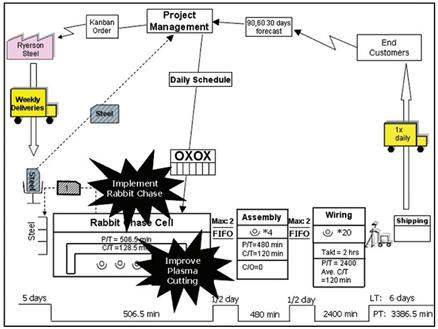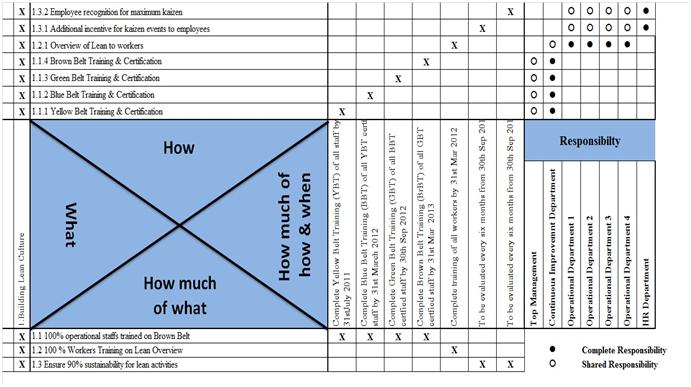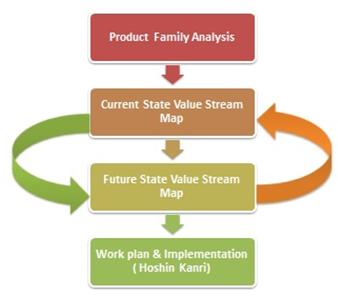- Articles ›
- Operations and IT ›
- A Roadmap for Lean Transformation Articles
A Roadmap for Lean Transformation
The Lean Philosophy emphasizes one basic point – ‘Doing more with less’. This article outlines a simple-to-understand three step road-map that can help an organization embark on its journey towards lean transformation. The first is a cultural revamp of getting the lean spirit through to everyone. Step two is to develop the organization’s current state value stream map, scan for improvement opportunities and then develop the desired ideal, or future state value stream map. Finally, step three is implementation wherein a powerful tool, Hoshin Kanri, is used to develop an effective action plan to achieve the desired future state.

‘There is nothing so useless as doing efficiently that which should not be done at all’ - Peter F. Drucker. Now when the father of management says something, the whole world stands up and takes notice.
Lean manufacturing or lean production or often simply, "Lean," is the buzzword in any industry nowadays. Lean can be defined as a systematic approach in identifying and eliminating waste or non-value adding activities through continuous improvement by making products on time with lowest cost, best quality and respect for humanity. In short, lean manufacturing means manufacturing without waste.In a modern business environment of unprecedented global competition every organization wants to stay ahead of the game by designing and offering better products and services by improving their manufacturing operations.
The origins of lean production can be attributed to Taiichi Ohno’s Toyota Production System which brought in a new wave in the manufacturing arena. Initially, the publication of the book The Machine that Changed the World (Womack et al., 1990) started the diffusion of some lean manufacturing practices developed by the most competitive auto manufacturers in the world. Thereinafter, lean production was studied and has been implemented in a host of other industries.
That brings us to the question - How should any organization embark on its Lean journey? What should be the strategy that the organization should adopt? What should be the starting point for executing that strategy? Lean manufacturing is much more than a technique; rather, it is a new way of thinking and a holistic system approach that aims to continuously improve operations. The following text lists down a three step approach for an organization to start its lean transformation.
Step I: Cultural Revamp
The first step towards building a lean organization is aninternal introspection; examination of an organization’s culture.Culture is a set of shared beliefs, attitudes and values of an organization (Ravasi and Schultz, 2006). If the basic beliefs and shared values of an organization do not match with the lean philosophy, steps must be taken to change the culture. However, culture is not something which can be changed overnight. An organization functioning over a period of time develops a set of methodology to function and conduct its daily operations. The desire togo the lean way should percolate from the top down – this desire needs support and commitment from the top management.
Step II: Value Stream Mapping (VSM)
The main focus of a lean organization is to create more value for the customer by eliminating waste. Any task in a manufacturing facility can be classified into one of the following three categories:
- Value adding activity (VA): Any activity that adds value to the product for which customer is willing to pay.
- Non value adding but necessary activity (NVAN): Any work carried out that does not increase product value but due to current state it can’t be eliminated.
- Non value adding activity (NVA): Any activity that adds cost to the product without adding value.
Identification and segregation of all operational activities into these three categories enables an organization to eliminate its NVAs.Value Stream Mapping is a lean manufacturing tool that illustrates the flow of materials, information and manufacturing data to identify improvement opportunities.VSM involves simply transferring information about the organization’s value stream to a ‘map’, which represents the current state of the manufacturing system. As the name implies, a current-state value-stream map presents a graphical representation of how both materials and information flow through the processes in the current system. Studying this current state value stream map, then helps identify areas of improvement or opportunities. The Figure 1 illustrates a sample current state value stream map.

Then the organizational value stream is mapped into a graphical representation depicting the future state of operations. A future-state VSM represents the ideal state of the manufacturing system.
Figure 2 illustrates a sample future state value stream map.

An important point to be noted here is that value stream mapping should be done for a single product family. This is so because of large variations in the product line. For example, in the textile industry the fabric produced varies in terms of quality, texture, color etc. Hence the VSM should be developed for particular product family. A thorough product family analysis should be performed before initiating the VSM process.
Development of the future state VSM from the current state VSM is an iterative procedure. This is because the future state VSM of today will become the current state VSM after certain period of time which will be used as reference to prepare the future state VSM again.
Step III: Hoshin Kanri
Once the organization has mapped out its value stream and identified opportunities for improvement, it must gear itself up for the most critical step – implementation. This demands an effective and realistic action plan enlisting how and when steps shall be be taken for removal of NVAs. The objectives of the plan must be specific and measurable for seamless execution. For this purpose the Japanese stalwarts have designed a powerful toolknown as Hoshin Kanri.
The Japanese translation of Hoshin Kanri is:
Ho- method; Shin- shiny metal showing direction; Kanri- planning
A useful interpretation of the literal translation is that Hoshin Kanri is a methodology used by an organization for establishing strategic direction. It is also known as Hoshin Planning, Policy Management or Policy Deployment. (Roberts, 2001)Hoshin Kanri means management and control of the company’s direction and focus. It is a roadmap that we follow for continuous improvement.
Figure 3 is a template which is generally used for developing a Hoshin Kanri.

- 1. General Policies/AIMS
- Answers the question “What” i.e. what are the improvements which the organization is looking for
- Must be targeted towards the most critical issues in the organization
- Should be specific and limited in number as each one grows as the Matrix expands
- 2. Global effects or results
- Answers the question “How much of What” i.e. how much of improvement is the organization looking for. It quantifies the improvement envisioned
- Important financial and benchmark objectives for the organization
- Non-business objectives that are equally or more important than business objectives
- The objectives must be feasible and have a multiplying effect
- A cross mark (X) is placed to indicate the relationship between the general policies and the effects
- 3. Strategies
- Answers the question “How” i.e. how improvements shall be carried out in the organization
- Specific improvement strategies are selected for each of the general policies
- A cross mark (X) is placed to indicate the relationship between the general policies, effects and strategies
- 4. Delivery/Goals
- Answers the question “ How much of How and When” i.e. the timeline for implementation
- Specific timelines are fixed for various improvement strategies
- Measurable goals for each selected strategy are preferred
- Objective information is welcome, but subjective information should not be ignored
- 5. Responsibility
- Answers the question “Who” i.e. who would be responsible for carrying out the strategies
- Complete or shared responsibilities are assigned
- Members in their natural work areas involved in the strategy must be included
An illustrative example shall make the concept of Hoshin Kanri much simpler. Let’s assumean organization is trying to build a lean culture and we want to develop a Hoshin Kanri for it.
The different sections of the Hoshin Kanri template could be: -
- 1. What: - Building a Lean Culture.
- 2. How much of what: - Define benchmarksfor different kinds of lean manufacturing related training you would like to impart to the management staff and workers which will help them understand lean concepts.
- How: -A step by step approach for the tasks listed in point 2 above.
- How much of how & when: - The timeline for completion of training.
- Who: - The department/concerned person who would be responsible for execution of the plan. This contains the names of people who have complete responsibility and shared responsibility.
Figure 4 is the Hoshin Kanri thus developed for the example above.

A summary of the three step approach described above can be understood from the following flow diagram. See Figure 5.

So we see that Lean is a set of principles and practices powerful enough to reduce costs to a great extent and increase profits in the long term.Through a relentless desire to eliminate waste and a simplification of all manufacturing and support processes, lean can do wonders for the organization. Of course in theory lean thinking is relatively simple, but in the real world of intense competition with companies vying to expand in or take away their share of the market, people are the center of the philosophy. Getting the lean spirit through to everyone is one of the most important phases. As always success depends solely on team efforts, a plethora of opportunities awaits...
References
1 Sánchez, A. M., & Pérez, M. P. (2001). Lean indicators and manufacturing strategies. International Journal of Operations & Production Management, 1433-1452.
2 Taj, S., & Morosan, C. (2011). The impact of lean operations on the Chinese manufacturing performance. Journal of Manufacturing Technology Management, 223-240.
3 Roberts, C. T. (2001). Hoshin Kanri: A Technique For Strategic QualityManagement. Quality Assurance International Manufacturing Centre, University of Warwick, 2.
4 Ravasi, D., & Schultz, M. (2006). Responding To Organizational Identity Threats: Exploring The Role Of Organizational Culture. The Academy of Management Journal, 4(3), 433-458.
5 Womack, J. P., Jones, D. T., & Roos, D. (1991). The Machine That Changed the World. Massachusetts: Harper Perennial.
This Articles has been co-authored by Alok Jaiswal and Ameya Wagle
Views expressed in the article are personal. The articles are for educational & academic purpose only, and have been uploaded by the MBA Skool Team.
If you are interested in writing articles for us, Submit Here
Share this Page on:
What is MBA Skool?About Us
MBA Skool is a Knowledge Resource for Management Students, Aspirants & Professionals.
Business Courses
Quizzes & Skills
Quizzes test your expertise in business and Skill tests evaluate your management traits
All Business Sections
Write for Us